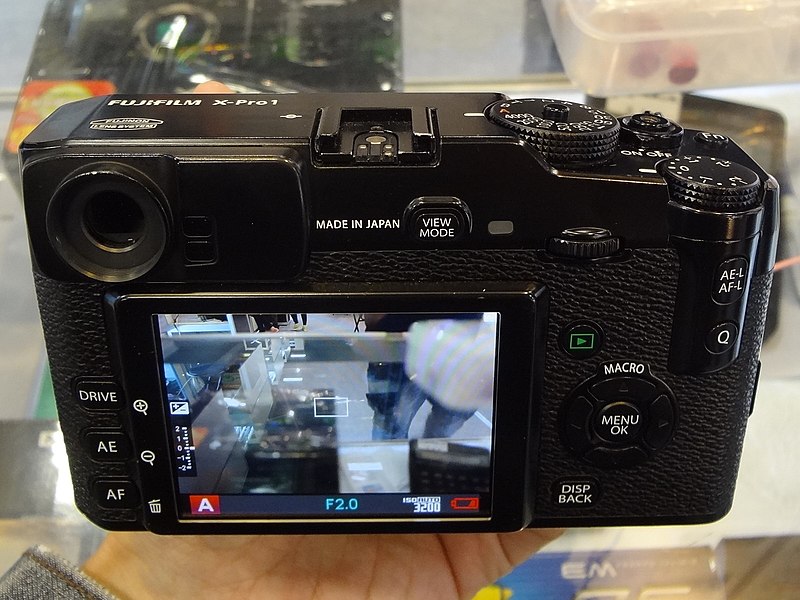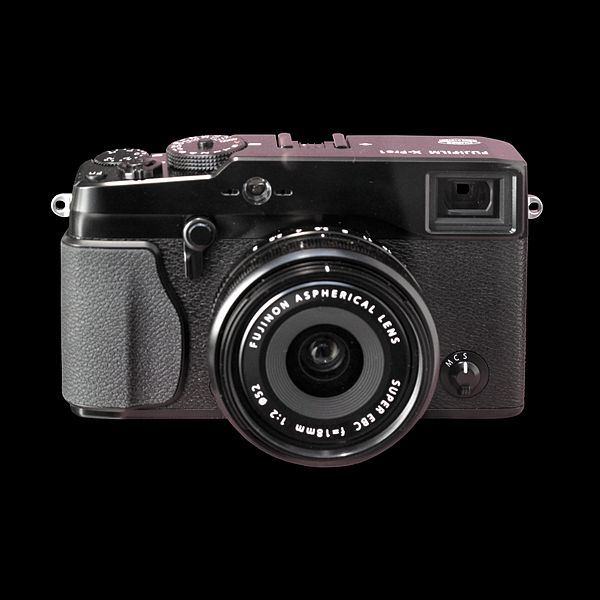The Fujifilm X-Pro1 is a mirrorless interchangeable-lens digital camera announced in January 2012 and launched in March 2012. It is part of Fujifilm's X-Series of cameras. In October 2012 Fujifilm has released a very similar, yet smaller, camera named the X-E1.
Key features

- 16-megapixel, APS-C sized "X-Trans" CMOS sensor
- Compatible with the Fujifilm X-mount system of lenses
- 2nd generation Hybrid Viewfinder
- TTL Hot Shoe and Sync Terminal
Fujifilm "X-Trans" CMOS sensor

The Fujifilm X-Trans CMOS sensor used in the X-Pro1 (and other Fuji X-series cameras) is claimed to provide higher resolution than full-frame sensors, and also produce better colour reproduction.
Anti-aliasing filters are used on standard Bayer Array Sensors to reduce moiré effect when shooting regular patterns - however they are known to slightly reduce resolution. The "X-Trans" CMOS sensor uses an irregular pattern of pixels (similar to that found on Silver halide film) in order to reduce moiré without the need for an AA filter.
This same irregular pattern ensures that all horizontal and vertical lines of pixels contain at least one R, G and B pixel whereas Bayer array sensors do not have R and B in some lines resulting in false colour reproduction.
Fujifilm X-mount lens system

Fujifilm developed their own lens mount specifically for the X-Pro1 (rather than license someone else's like in the case of the Fujifilm FinePix S5 Pro)
At the time of launch, 3 prime lenses were available:
- FUJINON XF18mmF2 R 18mm focal length (27mm 35mm equivalent) F2.0-F16 aperture, filter ⌀52mm
- FUJINON XF35mmF1.4 R 35mm focal length (53mm 35mm equivalent) F1.4-F16 aperture, filter ⌀52mm
- FUJINON XF60mmF2.4 R Macro 60mm focal length (91mm 35mm equivalent) F2.4-F22 aperture, filter ⌀39mm
On Sep. 6, 2012, Fujifilm announced two additional lenses for its X-mount:
- FUJINON XF18-55mmF2.8-4 R LM OIS 18-55mm focal length (27-83mm 35mm equivalent) F2.8-F4-F22 aperture, filter ⌀58mm
- FUJINON XF14mmF2.8 R 14mm focal length (21mm 35mm equivalent) F2.8-F22 aperture, filter ⌀58mm
Dec 2013 Fuji has add 2 primes and 4 zoom to be total of 6 Prime Lens and 5 Zoom lens.
- FUJINON XF 23mm F/1.4 (35mm in 135-film equivalent) high speed wide angle lens, filter ⌀62mm
- FUJINON XF 27mm f/2.8 (41mm in 135-film equivalent) pancake lens which is only 23mm thick, filter ⌀39mm.
- FUJINON XF 10-24mm f/4 ultrawide zoom lens, filter ⌀72mm
- FUJINON XF 55-200mm f/3.5-4.8 telephoto zoom lens, filter ⌀62mm
- FUJINON XC 16-50mm f/3.5-5.6 normal zoom lens, filter ⌀58mm
- FUJINON XC 50-230mm f/4.5-6.7' telephoto lens, filter ⌀58mm
The last two XC lenses are designed to suit mid range CSCs. Lower cost, smaller and lighter dimensions, but all transparent elements inside are made of glasses instead of high refractive plastics as in another (low cost) "kits lens".
Carl Zeiss Lenses with X-mount:
- Carl Zeiss Touit 2.8/12 E, Filter 47
- Carl Zeiss Touit 1.8/32 E, Filter 52mm
Fuji plans to release the high performance XF-series lens, the XF 56mm f/1.2 ultra high speed lens, around spring 2014.
The X-mount lens mount has a short flange back distance of just 17.7mm. This means the rear lens elements are as close as possible to the sensor. The wide opening allows the lens to be mounted deeper within the body â€" up to 7.5mm (approx) from the mount surface â€" reducing the back focus distance of each lens to the minimum possible.
Hybrid Viewfinder

Fujifilm’s Hybrid Viewfinder allows photographers to choose between an optical finder (OVF) and a high-resolution electronic view (EVF), complete with previews of depth of field and white balance. It also allows different optical magnifications and frame sizes to allow accurate framing with any of the XF-mount lenses in the system.
When an XF lens is mounted on the camera body, the most appropriate of the two available viewfinder magnifications is combined with the correct frame size.
Reviews

A number of reviews by popular photography websites have been very positive - with some noticeable negatives identified with the camera. The camera's high ISO performance is often cited as a strength, while reviews initially called out poor auto focus performance in low light and battery life as two of the main weaknesses. Since its release, several firmware upgrades have been released that have significantly improved autofocus speed.
Firmware updates
Fuji has adopted a "Kaizen" approach, meaning continual updates and innovation in releasing firmware updates to the X-Pro1. Since the launch of the camera, there have been 8 firmware updates to fix bugs, improve the camera's performance and add new features. Key areas improved include the camera's autofocus accuracy and speed, as well as new features such as focus peaking in the latest 3.0 firmware update.
